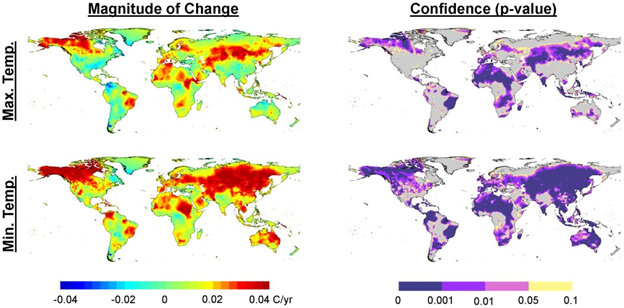Most scientists agree that the world is actually experiencing
increasing temperatures, and lots of believe that humans are enhancing this overall warming trend. The likely effects of worldwide warming won't be limited to at least one country or maybe one continent and can permeate almost every aspect of the environment and of life for all living things. Potential effects listed here are just a couple of these discussed within the Intergovernmental Panel on Climate Change’s (IPCC) 2007 report. Raising sea levels are the foremost common concern, taking place with a thermal expansion of the oceans a result of water molecules expanding in warmer temperatures, increased precipitation, and the melting of mountain glaciers. Because all bodies of water have varying shapes and ocean water tends to “swell” differently counting on its starting temperature. In the 20th century alone, sea levels rose 0.17 meters predictions for subsequent century range anywhere from 0.18 to 0.59 meters.
Climatology, branch of the atmospherically sciences involved each the outline of
climate and also the analysis of the causes of climatically variations and changes and their sensible consequences. Meteorology includes the systematic and regional studies of atmospherically conditions i.e., weather and climate.
Climate indices area unit large-scale weather patterns that area unit consistent and measurable. The goal of associate index is to combine sort of things into an outsized, generalized description of either air or ocean phenomena which can be accustomed track the worldwide climate system. According to the United Nations’ Intergovernmental Panel on
global climate change (IPCC), this scientific consensus of variations in solar activity plays a small role in climate change. Warming from increased levels of human-produced greenhouse gases is really repeatedly stronger than any effects thanks to recent variations in solar activity.
Environmental chemistry is the scientific review of the chemical and biochemical phenomena that occur in natural places. Environmental chemistry is described as the study of the sources, reactions, transport, effects of chemical species in the air, soil, and water environments; and also the effect of human activity on these. Environmental chemistry is an integrative science that has atmospheric, aquatic and soil chemistry, also as uses analytical chemistry. It is allied to environmental and other areas of science. It is different from green chemistry, which tries to trim potential pollution at its source. Whereas
Environmental engineering deals with the combination of sciences and engineering principles to develop the natural environment, to produce healthy air, water, and land for human habitation and for other organisms, and to procure pollution sites.
Pollution is that the presence of a waste within the atmosphere and is typically the results of human actions.
Pollution includes a prejudices impact on the atmosphere. Animals, fish and alternative aquatic life, plants and humans all suffer if the pollution is not controlled. One in every of the simplest issues that the earth is facing nowadays is that of environmental pollution, increasing with each passing year and inflicting grave and irreparable harm to the planet. In some cases, air pollutants, and greenhouse gases contribute to
Global climate change.
Marine pollution happens once probably harmful, effects result from the entry into the ocean of all types of waste like chemicals, particles, industrial, agricultural, and residential waste, noise, or the unfold of invasive organisms. The discharge of greenhouse gases causes the ocean to become hotter and causes the marine climate to become unfriendly leading to harm the marine system and marine life.
Environmental toxicology is an interdisciplinary field of science bothered with the study of the harmful effects of varied chemical, biological and physical agents on living organisms. Eco toxicology may be a sub discipline of
environmental toxicology bothered with studying the harmful effects of toxicants at the population and ecosystem levels. Organisms are often exposed to distinct sorts of toxicants at any life cycle stage, a number of which are more sensitive than others. Toxicity can also vary with the food web of organism's placement.
Bioaccumulation occurs when an organism cache toxicant in fatty tissues, which can eventually establish a trophic cascade and therefore the bio magnification of specific toxicants. The results of a chemical or other substance at various applications on various species.
Global Warming and climate change has already had observable effects on the environment. Glaciers have shrunk, ice on rivers and lakes is ending earlier, plant and animal ranges have shifted, and trees are flowering sooner. Effects that scientists had predicted within the past would result from
global climate change are now occurring loss of sea ice, accelerated water level rise and longer, more intense heat waves. In each of our nine cases, the extent of physical climate risk increases by 2030 and further by 2050. Across our cases, we discover increases in socioeconomic impact of between roughly two and 20 times by 2050 versus today’s levels. We also find physical
climate risks are increasing across our global country analysis whilst some countries find some benefits.
Earth science or geoscience includes all fields of science related to the planet Earth. This is often a branch of science managing the physical constitution of the planet and its atmosphere.
Earth science is that the study of our planet’s physical characteristics, from earthquakes to raindrops, and floods to fossils. The numerous purposes of the world sciences are to acknowledge the present capabilities and therefore the past evolution of the world and to use this information, whereby acceptable, for the advantage of human race. Some earth scientists use their information of the planet to seek out and develop energy and natural resources. Others study the impact of act on
Earth's environment, and elegance ways to guard the planet.
Carbon dioxide (CO2) capture and sequestration (CCS) could play an important role in reducing greenhouse gas emissions while enabling low-carbon electricity generation from power plants.
Carbon dioxide (CO2) capture and sequestration (CCS) can significantly reduce emissions from large stationary sources of CO2 which include coal- and
natural-gas-fired power plants, as well as certain industry types such as ethanol and natural gas processing plants.
Environmental or
Earth sciences, the fields of study concerned with the solid Earth, its waters, and therefore the air that envelops it. Included are the geologic, hydrologic, and atmospheric sciences. The broad aim of the world sciences is to know these features and therefore the past evolution of
Earth and to use this data, where appropriate, for the advantage of humankind. Thus, the essential concerns of the world scientist are to watch, describe, and classify all the features of the world, whether characteristic or not, to get hypotheses with which to explain their presence and their development, and to plan means of checking opposing ideas for his or her relative validity. In this way the foremost plausible, acceptable, and long-lasting ideas are developed.
Climate change plays a crucial role in the change of biodiversity of the planet. There is an ample evidence that climate change affects biodiversity. According to the Millennium Ecosystem Assessment,
global climate change is probably going to become one among the foremost significant drivers of biodiversity loss by the top of the century.
Climate change is already forcing biodiversity to adapt either through shifting habitat, changing life cycles, or the event of latest physical traits. In the air, gases, for example, water vapor, carbon dioxide, ozone, and methane act like the glass top of a nursery by catching warmth and warming the planet.
The jury remains out on whether a tree falling within the backwoods makes a sound, however it positively has an impact. That is particularly valid for imperiled and
endemic species, which just make them remain region of suitable lebensraum left on Earth, almost like Madame Berthe's mouse lemur in Madagascar, the
sky-blue toxic substance dash frog in Peru and Canada's challenging crane. New examination discovers the disturbing proof misfortune inside Alliance for Zero Extinction destinations of tree cover. From 2001 to 2013, AZE locales lost 3 million sections of land (1.2 million hectares) of tree cover. While this is often a moderately little measure of tree cover misfortune contrasted with worldwide midpoints, for species in AZE destinations, losing even a touch zone of tree cover can mean last chance.
A world during which neediness and imbalance are endemic will dependably be inclined to natural and different emergencies. Feasible improvement requires meeting the elemental needs of all and stretching bent all the prospect to satisfy their desires for a superior life. While
organic agriculture focuses on sustainability, regenerative agriculture takes things further. By working with nature,
regenerative agriculture can reverse global climate change by revitalizing ecosystems, increasing biodiversity and restoring soils degraded by industrial farming.
Renewable energy sources replenish themselves naturally without being depleted in the earth; they include bioenergy, hydropower, geothermal energy, solar energy, wind energy and ocean (tide and wave) energy.
Sustainable development has become the center of recent national policies, strategies, and development plans of many countries. The return-to-renewables will help mitigate climate change is an excellent way but needs to be sustainable in order to ensure a sustainable future and bequeath future generations to meet their energy needs.
A
greenhouse emission (sometimes abbreviated GHG) may be a gas that absorbs and emits energy within the thermal infrared range. Greenhouse gases cause the greenhouse effect on planets. The primary greenhouse gases in
Earth's atmosphere are water vapors (H2O), CO2 (CO2), methane (CH4), laughing gas (N2O), and ozone (O₃). Without greenhouse gases, the typical temperature of surface would be about −18 °C (0 °F), instead of this average of 15 °C (59 °F). The atmospheres of Venus, Mars and Titan also contain greenhouse gases.
Marine Species suffering from global climate change include plankton - which forms the idea of marine food chains - corals, fish, polar bears, walruses, seals, sea lions, penguins, and seabirds. The Intergovernmental Panel on global climate change predicts an extra rise of between 1.4°C and 5.8°C by the top of the century.
Climate change could therefore rather be the knock-out punch for several species which are already under stress from overfishing and habitat loss. A study has shown that fish within the North Sea have moved further north or into deeper water in response to rising sea
temperatures. Other species may lose their homes for other reasons. The distribution of penguin species within the Antarctic Peninsula region, for instance, is changing with reductions in sea ice thanks to heating.
An ecosystem covers of all the organisms in an area, the community, and the abiotic aspects that influence that community.
Ecosystem ecologists usually focus on course of energy and recycling of nutrients. Ecology is the study of how organisms act together with one more and with their
physical environment. The supply and abundance of organisms on Earth is shaped by
biotic, living-organism-related, and abiotic, non-living or physical, factors. Ecology develops our world and is vital for human wellbeing and prosperity. It affords new knowledge of the interdependence between people and nature that is energetic for food production, preserving clean air and water, and sustaining
biodiversity in a changing climate.
Environmental engineering is a professional engineering discipline that encompasses broad scientific topics like chemistry, biology, ecology, geology, hydraulics, hydrology, microbiology, and mathematics to create solutions that will protect and also improve the health of living organisms and improve the quality of the environment. Environmental engineering is a sub-discipline of civil engineering and
chemical engineering.
Physical Climate models are unable to reproduce the rapid warming observed in recent decades when considering only variations in solar output and volcanic activity. As the Sun is that the
Earth's primary energy source, changes in incoming sunlight directly affect the climate system. If solar variations were liable for the observed warming, warming of both the
troposphere and therefore the stratosphere would be expected, but that has not been the case.
Explosive volcanic eruptions represent the most important natural forcing over the economic era. When the eruption is sufficiently strong (with Sulphur dioxide reaching the stratosphere) sunlight are often partially blocked for a few of years, with a temperature signal lasting about twice as long. In the industrial era, volcanic activity has had negligible impacts on
global temperature trends.
Adaptation is "the process of adjustment to current or expected changes in climate and its effects". As global
climate change effects vary across regions, so do adaptation strategies. While some adaptation responses involve trade-offs, others bring synergies and co-benefits. Increased use of air con allows people to raised deal with heat, but also increases energy demand. Other samples of adaptation include improved
coastline protection, better disaster management, and therefore the development of more resistant crops.
Adaptation is especially important in developing countries since they are predicted to bear the brunt of the effects of climate change. The capacity and potential for humans to adapt, called adaptive capacity, is unevenly distributed across different regions and populations, and developing countries generally have less. There are limits to adaptation and more severe global
climate change requires more transformative adaptation, which may be prohibitively expensive.
The impact of climate change on
waste management infrastructure is likely to become increasingly important and there are some threats which should not be ignored. Landfills have a significant long-lived pollution potential due to slow degradation of biodegradable content and insufficient flushing of leachate through the contained material. Current infrastructure may be vulnerable to flooding, with the incidence of more extreme weather events. The impacts need to be understood and measures put in place to ensure that resilience to such events is adequate. There are also potential waste and public health impacts in the aftermath of extreme
catastrophic events. The waste management sector was responsible for around 4 percent of UK greenhouse gas emissions in 2013, with methane being by far the most prominent gas (91 percent). The vast majority of these emissions are from landfill sites.
Rehabilitation emphasizes the reparation of
ecosystem methods, productivity and services, while the goals of restoration also comprise the re-establishment of the pre-existing biotic integrity in terms of species composition and community structure.
Restoring ecosystems massive and slight guards and advances the livelihoods of people who depend on them. It also helps to normalize disease and decrease the threat of natural disasters. In detail, restoration can assist us attain all of the Sustainable Development Goals.
As a renewable energy source, biofuels have great potential. They are made by converting plants, algae, or animal waste into fuels. Biodiesel is thought to be a renewable energy source as such feedstock materials can be readily restocked, Unlike other renewable energy sources like petroleum, coal, and gas, biomass can be converted directly into liquid fuels, called "
Biofuels," to help meet transportation fuel necessities.
Biomass undergoes fermentation process for turning to ethanol (biofuel). Microorganisms (such as bacteria and yeast) digest plant carbohydrates and generate ethanol during fermentation. Bioenergy is one of many different options available to help us fulfill our demand for energy. This is derived from presently residing natural materials known as biomass, which may be used to provide transportation fuels, warmth, power, and products.
Track 23: Environmental Sustainability
Environmental sustainability is important because of how much energy, food and human-made resources we use every day. Rapid population growth has resulted in increased farming and manufacturing, leading to more greenhouse gas emissions, unsustainable energy use, and deforestation.
Track 24: Green Energy and Green Chemistry
Environmentally friendly power vitality originates from normal sources, for example, daylight, wind, downpour, tides, plants, green growth and geothermal warmth. These vitality assets are sustainable, which means they're normally renewed. Interestingly, non-renewable energy sources are a limited asset that take a huge number of years to create and will keep on lessening with use. Sustainable energy can be defined as a form of energy that can be utilized again and again without putting a source in danger of getting depleted, expired, or vanished.
Green chemistry is the design of chemical products and processes that reduce or eliminate the use or generation of hazardous substances. Green chemistry applies across the life cycle of a chemical product, including its design, manufacture, use, and ultimate disposal.
Track 25: Oceans and Climate Change
Ocean Covers 70 percent of the Earth's surface, the world's oceans have a two-route association with climate and atmosphere. The seas impact the weather on nearby to worldwide scales, while changes in atmosphere can in a general sense regulate numerous properties of the seas. This portion looks at how some of these vital features of the seas have changed after some time.
As nursery gasses trap more vitality from the sun, the oceans are engrossing more warmth, bringing about an development in ocean surface temperature and growing ocean level. Changes in ocean temperature and stream achieved by environmental change will prompt changes in atmosphere designs the world over. For example, hot water may advance the improvement of more grounded storms in the tropics, which can cause property harm and death toll. The effects related with ocean level rise and more grounded storms are particularly pertinent to beach front groups. Changes in sea frameworks by and large happen over any longer eras than in the environment where tempests can shape and disperse in a solitary day. Associations between the seas and climate happen gradually finished numerous months to years, thus does the development of water inside the seas, including the blending of profound and shallow waters.
Track 26: GIS and RS in Climate Change
Present day GIS advances utilize computerized data, for which different digitized information creation strategies are utilized. The most well-known strategy for information creation is digitization, where a printed copy guide or overview plan is moved into an advanced medium using a PC helped outline (CAD) program, and geo-referencing capacities. With the wide accessibility of ortho-redressed symbolism (both from satellite and aeronautical sources), heads-up digitizing is turning into the principle road through which geographic information is removed. Heads-up digitizing includes the following of geographic information specifically on top of the elevated symbolism rather than by the conventional technique for following the geographic shape on a different digitizing tablet (heads-down digitizing).
Remote detecting is the procedure where the Remote sensors gather information by recognizing the vitality that is reflected from the earth. These sensors may be on satellites or mounted on airplanes. The electromagnetic radiation is ordinarily utilized as a data transporter as a part of remote detecting. Remote sensors assemble data by measuring the electromagnetic radiation that is reflected, discharged and consumed by articles in different ghostly districts, from gamma-beams to radio waves.
Track 27: Business Modelling for Sustainability
Lia Colabello, managing principal of Plastic Pollution Solutions, raised the point that there’s a difference between a sustainable business model and a business model that prioritizes sustainability.
“A sustainable business model is what every business leader hopes to achieve: that the business will turn a profit quickly and stay afloat for the long term,” she said. “A business model that prioritizes sustainability is one that, at a minimum, considers all stakeholders, assesses and addresses environmental impacts, and is transparent and thorough in its reporting.”
Market Insights of Global Warming-2022
Environmental Science is generating energy that produces no greenhouse emissions from fossil fuels and reduces some sorts of pollution. The renewable energy business remains one in all the most vibrant, fast-changing, and transformative sectors of the worldwide economy. Technology enhancements, cost declines, and also the catalytic influence of recent financing structures, have turned the world into a driver of economic growth round the world. The renewable-energy industry is that the part of the energy industry that specialize in new and acceptable
renewable energy technologies. Investors worldwide have paid greater attention to the present rising business in recent years.
The worldwide renewable energy market is anticipated to grow significantly throughout the forecast period due to increased emissions of
greenhouse gases (GHGs), significantly greenhouse gas because of utilization of fossil fuels for generation of energy. Additionally, restricted presence of fuel on the planet in addition its volatile prices fuels the renewable energy market; However, generation of energy from renewable sources needs large investment. This issue is anticipated to hamper the
market growth throughout the forecast period. Moreover, in the Middle East,
fossil fuels are majorly used to generate energy because of its price effective nature as compared to alternative regions. This hampers the expansion of the market. The renewable energy market was expected to achieve high by 2025. The worldwide renewable energy market was valued at $928.0 Billion in 2019, and is expected to achieve $1,512.3 billion by 2025, registering a CAGR of 6.1% from 2015 to 2025.
Environmental Analysis is an interdisciplinary major that specialize in the interaction between human and non-human components of the biosphere. The major applies approaches within the social sciences, arts and humanities, and natural sciences to understanding and solving environmental problems. Climate change can significantly affect water systems and important infrastructure as precipitation patterns change in duration, frequency and site. GSI develops tools and methods to assess impacts of global
climate change on surface water and groundwater resources and dam operations. Projects have included assessing accelerated erosion thanks to flooding from extreme rainfall events and water system reliability for an outsized metropolitan area under changing rainfall patterns. El Nino - Southern Oscillation (ENSO) is that the primary source of inter-annual variability in climate for the Southeast Asia region.
Pacific Decadal Oscillation (PDO) has also got a strong correlation to climate variability. There is growing awareness of the potential use of seasonal forecasting for medium-term planning and model analyses of decadal scale changes in
climate variability. Such forecasting processes need historical climate data so as to conduct analyses. RIMES carries out extensive rainfall analysis over Asia and Africa with data from various sources like TRMM, GPCP, NCDC, and from National Meteorology Departments, to spot climate variability and its impacts. This area of labor is meant to know how and why climate varies. It involves developing modeling capability to estimate how the climate will change within the future, also as developing climate projections for both research and long-term planning.

Temperature:
-
As more and more heat-trapping greenhouse gases are emitted; the atmosphere warms up.
-
This warmer air results in more water evaporating from our oceans, rivers, lakes, and land, and entering the atmosphere.
-
Warmer air also holds more water vapor, and water vapor itself traps heat.
-
The additional water vapor within the already warmer air retains even more heat, amplifying the initial warming.
-
Even more warming results in even more water evaporating, starting the cycle once again. And again, and again.
The disappearance of Arctic sea ice is quickly occupation the direction of an irreversible tipping point. Indeed, many researchers believe it’s a question less of if than when we will begin seeing sea ice-free summers in the Arctic.
“With
current global emission rates of 35 to 40 billion metric plenty of CO2 annually, we may get our first glimpses of ice-free Septembers within the next 20 to 25 years, once we will have added another 800 billion metric tons to the atmosphere,” Scientific American explains. “Yet it does not stop there. Other months of the year will become ice-free with additional atmospheric CO2. For example, with another 1,800 billion metric plenty of CO2, the Arctic will likely haven't any ice from July through October.”
It’s worth noting that this assessment is taken from a piece of writing that begins by admitting
that “observed ice loss is usually happening faster than climate models have forecasted.”
Greenhouse Gases:
Climate Change may be a result of a posh system of interactions of
greenhouse gases (GHG), the ocean, land, ice, and clouds. Large global climate change models use several computers and solve several equations to predict the longer-term climate. The equations may include simple polynomials to partial differential equations. Because of the uptake mechanism of the land and ocean, greenhouse emission emissions can take a short time to affect the climate. The IPCC has published reports on how
greenhouse emission may affect the typical temperature of the troposphere and therefore the predictions show that by the top of the century, we can expect a temperature increase from 0.8 C to 5 C. In this article, i exploit rectilinear regression (LM),
Quadratic Regression and Gaussian Process Regression (GPR) on monthly GHG data going back several years and check out to predict the temperature anomalies based on extrapolate action. The results are quite similar to the IPCC reports.





























